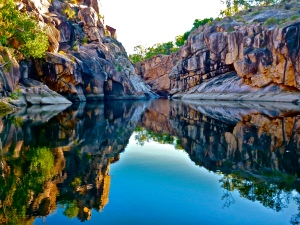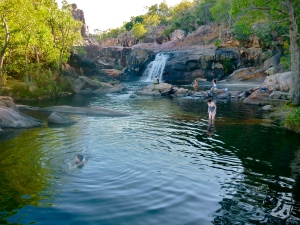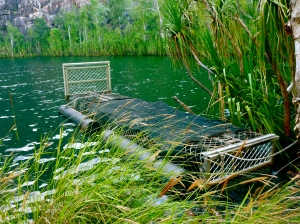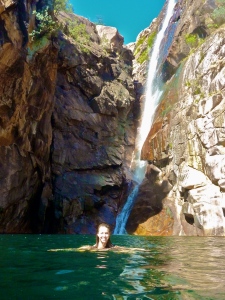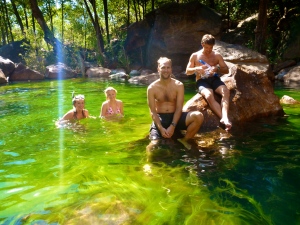Leading up to my time in Darwin, everyone made it sound like there was nothing to do in the actual city other than signing up for tours in the surrounding National Parks. Having already been to Kakadu and Litchfield with Adventure Tours, I thought this may result in a bit of a struggle. Though it was rather small, I loved Darwin! I can see how it could be boring after awhile, but I wish I had stayed longer than a week. Everything you needed in Darwin could be found on Mitchell Street, but there were about 5 square blocks worth wandering through.
Side note: I would advise all backpackers to stay at Youth Shack because it’s right in the center of everything, and from what I hear, everyone preferred it over the other hostels on that strip. The YHA is apparently horrible, which comes as a surprise to me because it’s usually a safe bet (albeit more expensive). I stayed at the Cavenagh (aka The Cav) and quite liked it! There was a nice pool in the center, which was always very social, and a bar and bistro that stayed open until 10pm every night. Perfect if you’re traveling alone!
Most of my time in Darwin was spent wandering around and relaxing, but I have 3 events in particular that I find worthy of sharing…
Deckchair Cinema
“Where stars light the screen.” This outdoors cinema was unlike any other because of its dinner buffet, decently stocked bar of beer and wines, movie munchies, and of course the lawn chairs! I was accompanied by my Italian friend, Marco, whom I met on the Groovy Grapes tour up to Alice Springs. The flick of the night was Once Upon a Time in the West, a classic Western movie which I’ve actually never seen before. And Marco hadn’t seen it since his childhood, so he was happy to revisit the cinematography and soundtrack. The stairway leading down to the cinema was blocked off for some unknown reason, so it took us about half an hour to actually find our way to the Deckchair Cinema. We arrived just as the movie was starting, so I didn’t get a chance to snap a picture, but I found it enchanting enough that a Google search seemed necessary for sharing.
I would have really preferred to have seen Griff the Invisible or Red Hill, both of which are Australian films starring Ryan Kwanten, the hottie from True Blood! But the old Western added a little extra to the whole idea of the classic outdoors cinema.
Mindil Beach Sunset Markets
These markets take place year round on Sundays and Thursdays. I was thrilled to have the opportunity to go to one of them! I caught a bus just down the street from the Cav for $2, which dropped me off 3km later right in front of the markets. Immediately you see the hoards of people flooding in for this special attraction.
Live music was around every corner, my favorite of course being Em Dee, “high-tech didgeridoo meets drum n’ bass.” Not only did it look difficult with how much he was taking on at a single time, but the music was actually pretty good! I almost wish I had stuck around to purchase one of his CDs. Dance partayyy!
The booths consisted of pretty much everything you would expect: t-shirts, mugs and coozies, crocodile and kangaroo skins, jewelry made of coconuts and shells, south sea pearls, opals, didgeridoos, boomerangs, southeast Asian dresses and fisherman pants, etc. I found a cute little hand-made bracelet for myself!
Of course an entire lane was also dedicated to an eclectic mix of grab-and-go foods as well. I tried some goat and wallaby-on-a-stick but settled with a delicious crocodile burger. It’s surprisingly better when it’s not fried – in which case, yes of course it tastes like fried chicken!
I was so mesmerized by all the booths’ offerings that I hardly noticed the sun setting until everyone flooded the beach.
The sign leading to the beach was rather heartwarming: WARNING! No swimming due to crocodiles, sharks and box jellyfish… Noted! Thank you! (I will not be swimming this evening.)
When the sun finally went down, many of the people went home. However the markets stayed open until 10pm. And the night performers took over!
Overall, it was a fabulous night of shopping, food, beach and entertainment all jumbled into one!
Crocosaurus Cove
Alas, my final adventure takes place right in the heart of Darwin! Croc Cove is home to the biggest tourest trap of all: The Cage of Death. Essentially what they do is place you inside a glass cage that is lowered right into the tank with a massive saltwater crocodile. Initially these salties would go mental at the sight of a person in their cage and would swim right up to them, banging, trying to find a way in to eat them… supposedly. Now they have gotten so used to all these tourists that they hardly even pay attention to them. I actually witnessed this poor guy get lowered into a tank all fired up with his underwater camera, and the crocodile was just chilling on the bank of the water. The guy submerged a couple times to try and take a picture, but I don’t think he could even get one. Lame! But good in theory. I probably would have done it myself if some Darwinians hadn’t warned me about it first.
That being said, one girl was lucky enough for her “near death experience” to take place during the croc feeding, which takes place twice a day. I’m not sure how much different it would have been from her side of the glass, but I guess it was pretty cool to watch!
You hear a lot about the jumping crocs in Darwin. In order to catch prey such as bats or birds that fly and perch in trees, the crocs will actually swim upward with such great force that their tail can propel them out of the water. Whereas larger crocs can get about half of their body out of the water (still a few meters!), the little crocs can clear the water by several feet! I was unable to catch the peak of its jump on camera, but I was able to witness one croc make a bold attempt to jump for his flesh-on-a-stick.
Perhaps my favorite part of the day was getting to play with all the baby crocs. And by play, I mean fish for them. Following both of the croc feedings, guests are given the opportunity to enter a platform above the baby crocs where they can feed them from a fishing pole.
The strategy is to splash the meat in the water where there are no crocs. This gets their attention so that they will swim for it. Once their eye is on the prize, you hold the meat up above the water so that the little guys will jump for it. So cute!
After the fishing/feeding session, I wandered into the World of Crocs exhibit, where I was allowed to hold a baby croc!
I felt a little guilty holding it because the poor thing had been kept in a teeny tiny little locker for his “shift” this afternoon. It kept peeing on the caretaker, who did not seem enthused about working there. When I asked “does this hurt him?” he shrugged it off with a “BAH’DUNNO!” I’m gonna guess it couldn’t have been comfortable for him, considering how much he weighed and that I was holding him by the neck. The underside of their body is quite soft and vulnerable in comparison to their backside. Poor thing! But I did get to hold a baby croc…
Darwin was a blast! Wish I could have stayed longer, but now I’m off to Cairns 🙂
















